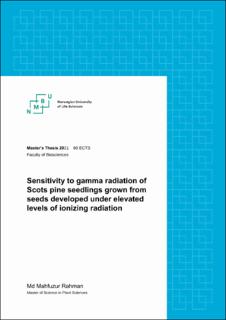| dc.description.abstract | As being sessile, plants are generally exposed to background levels of ionizing radiation in their natural environment due to cosmic radiation as well as alpha-, beta- or gamma- emitting radionuclides in naturally occurring radioactive materials (NORM) including thorium, uranium and their progeny radionuclides in bedrocks, sediments and soils. Also, some areas have elevated, potentially harmful levels of radiation arising particularly from anthropogenic sources including fuel cycles and nuclear power plant accidents, tests and use of nuclear weapons as well as medical use. Such radiation at low and high doses can induce various physiological, biochemical and molecular responses in plants and can cause adverse effects such as reduction in growth and reproduction, and damage to DNA, proteins and lipids.
Due to its high energy, gamma radiation has high penetration power in biological tissues and its effects on living organisms have accordingly been much studied. Long-term study results in plants have demonstrated detrimental effects and mutations even at low levels of ionizing radiation. Coniferous plants are suggested to be among the most radiosensitive plant species, and pine trees showed high-level of radiosensitivity after the Chernobyl and Fukushima nuclear power plant accidents. However, studies of sensitivity to gamma radiation of plant seedlings under controlled exposure conditions are scarce, especially for low to moderate dose rates. Also, there is limited information about how elevated levels of ionizing radiation during seed development affect the radiosensitivity in the plants grown from these seeds.
The present study aimed to investigate the sensitivity to gamma radiation in seedlings of the ecologically and economically important gymnosperm Scots pine when grown from seeds from different areas in the Chernobyl region with background (CON), intermediate (INT) and high (TR22) levels of ionizing radiation. Such seedlings were exposed to gamma dose rates from 0-100 mGy h-1 from a 60Co (Cobalt-60) source for 144 h and studied across multiple levels of biological organization at the end of the gamma irradiation and up to 29 days postirradiation. In addition to growth and development, DNA damage, total antioxidant capacity and expression analysis of genes involved in control of cell division and DNA repair were assessed.
In spite of significantly increased root and shoot lengths of TR22 seedlings at 10 mGy h-1 and 0-40 mGy h-1 , respectively, compared to the unexposed CON seedlings, at the end of the gamma irradiation, there was no clear dose-response relationship between the gamma dose rates and plant lengths for any of the plant types. Post-irradiation, the number of needles and shoot diameter were reduced at ≥ 40 mGy h-1 for all three plant types, but shoot elongation was not significantly affected. However, there was no overall significant difference in growth in response to the different gamma irradiation dose rates between the plant types.
All the plant types showed a clear dose-rate dependent DNA damage as assessed by the COMET assay at the end of the 144 h gamma irradiation and at day 30 post-irradiation. At the end of the irradiation, the TR22 and INT plants showed significantly lower DNA damage than the CON plants at ≥ 40 mGy h-1 . Such differences were also observed day 30 postirradiation, but most pronounced so for TR22. Despite the differences in DNA damage, the different plant types did not show any significant differences in total antioxidant capacity measured by the FRAP assay after 144 h gamma irradiation. The relative transcript level of the cell division controlling gene CYCB1;1 was then significantly reduced in TR22 seedlings at 100 mGy h-1 compared to the unexposed CON seedlings, but the CDKB1;2 expression did not differ significantly between the different dose rates and plant types. The transcript level of the DNA repair-related RAD51 gene was significantly downregulated in TR22 seedlings at 10 mGy h-1 as compared to unexposed CON seedlings, whereas the SOG1 transcript level did not differ significantly between the plant types. Thus, except for a possible slight trend of a dose-rate dependent reduction in CYCB1;1 expression and more so in the TR22 than the CON plants, there was no clear, systematic dose-response relationship between the gamma dose rates or plant types and transcript levels of the analyzed genes.
In conclusion, in spite of that, more DNA damage in the CON plants than the INT and TR22 plants after gamma irradiation at 40 and 100 mGy h-1 suggested lower radiosensitivity in the plants grown from seeds developed under elevated levels of ionizing radiation, this was not reflected in their growth, total antioxidant capacity or expression of selected cell divisionand DNA damage repair-related genes. | en_US |

